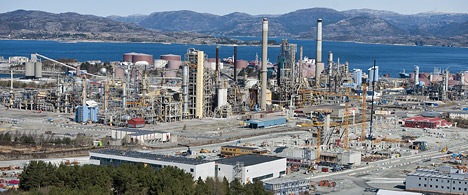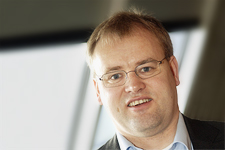
The Mongstad facility near Bergen. (Photo: Helge Hansen)
The work on full-scale CO2 capture will enter a new phase when Statoil and Gassnova embark on the joint process of prequalifying relevant suppliers for the capture facility at Mongstad.
The prequalification lays the foundation for an open international tender competition which will be conducted in accordance with the EEA’s procurement regulations, wherein the suppliers must document experience and capability to deliver a capture facility with amine-based technology that is sufficiently matured to commence construction at Mongstad from 2014.
This means that suppliers have to document factors such as technology and experience in delivering large, complex plants. The prequalification process will be concluded during the autumn of 2010.
The project will then select a number of companies to receive study contracts and to participate in the pre-engineering phase where the technical concept will be further engineered.

Kurt Georgsen, Statoil’s head of the full-scale project at Mongstad.
Ultimately, these companies will compete for the final construction contract for the capture facility. The final selection of supplier is scheduled for 2013, when an EPC contract will be signed.
“Participation in the prequalification is only open to suppliers of amine-based technology, as this is the only technology regarded as being sufficiently matured for construction at Mongstad within the set timeframe,” says Statoil’s head of the full-scale project at Mongstad, Kurt Georgsen.
The capture facility will be integrated into a refinery and combined heat and power plant (CHP) in operation. This implies that the regularity of the capture plant will be important. The integration will also have implications for the construction phase.
Oil and gas at the industrial plant pose safety challenges. Furthermore, the plant is connected to important fields on the Norwegian continental shelf, such as Troll and Gjøa. At the same time, the technology must be scaled up many times compared with the largest capture facilities in the world today.
“This is a complicated facility that will be integrated with an existing industrial plant. We will be conducting detailed reviews with the potential suppliers to ensure that they thoroughly understand both the scope and the complexity,” says project manager Julia Lindland from Gassnova.
Comprehensive studies aimed at clarifying potential health risks associated with amine emissions started in May and June. This work is expected to provide a basis for testing the specific amine solutions in the first part of the detailed engineering phase, sometime in 2012.
“We must be certain that all health-related factors associated with emissions from the amine process have been clarified and verified. Therefore, we are devoting considerable resources in the next few years to securing more knowledge, as well as developing good methods for sampling and analysis. We are using the best independent research communities in the world, in addition to our own experts,” says Statoil’s project manager Petter Bryn.
“We will face substantial challenges as regards detailed engineering of utility systems and in integrating the capture facility with the refinery and the combined heat and power plant,” says Bryn.
The process of prequalifying relevant CO2 capture suppliers is expected to be completed in August, and the plan is to establish study contracts with the suppliers towards the end of 2010. Concept development and pre-engineering will take place during the period 2011 to 2013, and will form part of the basis for a final investment decision in 2014.